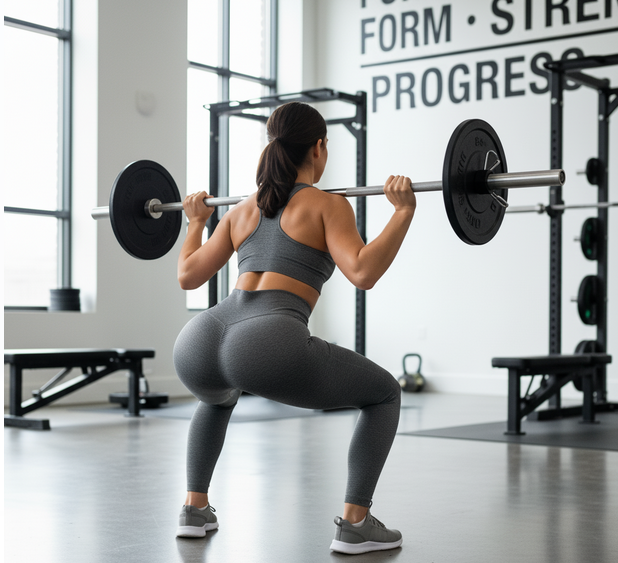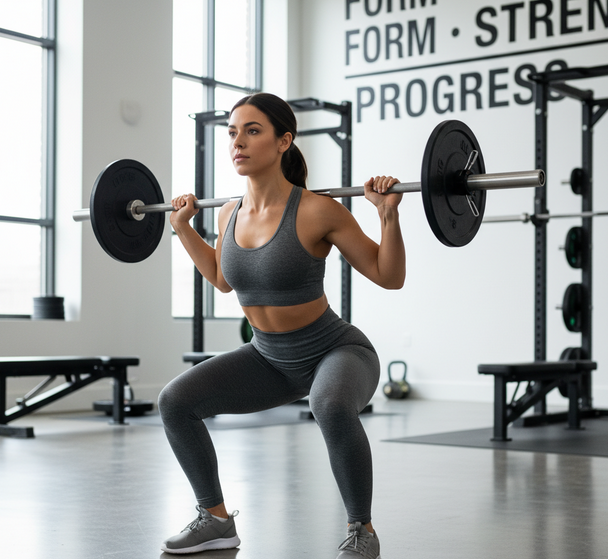
Introduction
Building stronger, more shapely buttocks has become increasingly popular among women seeking to improve their overall fitness and body confidence. The gluteal muscles—comprising the gluteus maximus, medius, and minimus—are not only important for aesthetic appeal but also play a crucial role in posture, athletic performance, and injury prevention. This comprehensive guide will explore evidence-based methods to naturally enhance your buttocks through targeted exercises, proper nutrition, and healthy lifestyle choices.
Whether you're a beginner starting your fitness journey or an experienced athlete looking to improve your glute development, this article provides practical strategies that can help you achieve your goals safely and effectively.
Understanding Buttock Anatomy and Function
The buttocks consist of three primary muscles that work together to provide stability, power, and shape. The gluteus maximus is the largest muscle in the human body and is responsible for hip extension, external rotation, and maintaining an upright posture. The gluteus medius and minimus, located on the sides of the hips, help with hip abduction and stabilization during movement.
These muscles are essential for everyday activities such as walking, climbing stairs, and standing up from a seated position. Strong glutes also help prevent lower back pain, improve athletic performance, and contribute to better overall body alignment. Understanding this anatomy helps explain why targeted glute training can be both functional and aesthetic.
Evidence-Based Exercise Strategies
Research consistently shows that compound movements combined with isolation exercises provide the most effective approach to glute development. The key is progressive overload—gradually increasing the challenge to your muscles over time through added weight, repetitions, or exercise complexity.
Squats remain one of the most effective exercises for overall glute development. Variations such as sumo squats, Bulgarian split squats, and goblet squats target different aspects of the glute muscles. Hip thrusts have gained recognition as particularly effective for gluteus maximus activation, with studies showing they can produce higher muscle activation than traditional squats.
Deadlifts, including conventional, sumo, and Romanian variations, are excellent for building both strength and size in the posterior chain. These exercises work the glutes in conjunction with the hamstrings and lower back, creating functional strength patterns that translate to real-world activities.
Essential Exercises for Buttock Enhancement
- Hip Thrusts: Lie on your back with knees bent, feet flat on the floor. Lift your hips up by squeezing your glutes, creating a straight line from knees to shoulders. Hold for 2-3 seconds at the top.
- Squats: Stand with feet shoulder-width apart, lower your body as if sitting back into a chair, keeping your chest up and knees tracking over your toes. Return to standing position.
- Lunges: Step forward with one leg, lowering your hips until both knees are bent at approximately 90 degrees. Push back to the starting position and repeat with the other leg.
- Step-ups: Using a sturdy platform or bench, step up with one foot, driving through your heel to lift your body up. Step back down with control and repeat.
- Glute Bridges: Similar to hip thrusts but performed on the floor. Focus on squeezing your glutes at the top of the movement while keeping your core engaged.

Progressive Training Program Design
A well-structured program should include both strength training and targeted activation work. Beginners should start with bodyweight exercises 2-3 times per week, focusing on proper form before adding external resistance. As strength improves, incorporating weights, resistance bands, and more challenging variations becomes important for continued progress.
A sample weekly structure might include two focused glute sessions with compound movements, one day of isolation exercises, and one day of lower-intensity activation work. Rest days are crucial for muscle recovery and growth, so avoid training the same muscle groups on consecutive days.
Tracking your progress through measurements, photos, or strength gains helps maintain motivation and allows for program adjustments. Many women see noticeable changes within 6-8 weeks of consistent training, with more significant transformations occurring over 3-6 months of dedicated effort.
Nutrition for Muscle Development
Building muscle requires adequate protein intake, typically 0.8-1.2 grams per pound of body weight for active women. High-quality protein sources include lean meats, fish, eggs, dairy products, legumes, and plant-based options like quinoa and hemp seeds.
Carbohydrates provide the energy needed for intense workouts and should comprise 45-65% of total daily calories. Complex carbohydrates such as whole grains, fruits, and vegetables support sustained energy levels and recovery.
Healthy fats, including those from nuts, seeds, avocados, and olive oil, support hormone production and overall health. Adequate hydration is also essential for muscle function, recovery, and nutrient transport throughout the body.
Recovery and Lifestyle Factors
Quality sleep is crucial for muscle recovery and growth hormone production. Aim for 7-9 hours of sleep per night to optimize your body's natural recovery processes. Poor sleep can significantly impact your training results and overall health.
Managing stress through techniques such as meditation, yoga, or regular relaxation practices helps maintain hormonal balance and supports muscle development. Chronic stress can interfere with recovery and muscle building processes.
Consistency is perhaps the most important factor in achieving results. Regular training sessions, even if shorter or less intense occasionally, will yield better results than sporadic, intense workouts followed by long periods of inactivity.
Common Mistakes to Avoid
Many women make the mistake of focusing exclusively on isolation exercises while neglecting compound movements that provide greater overall muscle development and functional strength. Another common error is not progressively increasing the challenge level, which leads to plateaus in results.
Neglecting proper form in favor of heavier weights can lead to injury and less effective muscle activation. It's better to use lighter weights with perfect form than to compromise technique for ego lifting.
Expecting immediate results can lead to disappointment and abandonment of otherwise effective programs. Muscle development is a gradual process that requires patience and consistency over weeks and months.
Safety Considerations and When to Seek Professional Help
Always prioritize proper form over heavy weights or high repetitions. If you experience pain during or after exercises, stop immediately and consider consulting a healthcare provider or certified fitness professional.
Individuals with pre-existing injuries, particularly in the lower back, hips, or knees, should seek guidance from a qualified trainer or physical therapist before beginning an intensive glute training program.
Consider working with a certified personal trainer, especially when starting out, to ensure proper exercise technique and program design tailored to your individual needs and goals.
Realistic Expectations and Timeline
Muscle building is influenced by genetics, age, training history, and consistency. While some women may see changes within a few weeks, significant transformations typically require 3-6 months of dedicated training and proper nutrition.
Focus on strength gains, improved posture, and how you feel rather than solely on appearance changes. These functional improvements often occur before visible aesthetic changes and provide lasting benefits for overall health and quality of life.
Remember that everyone's body responds differently to exercise, and comparing your progress to others can be counterproductive. Focus on your own journey and celebrate small victories along the way.
Alternative Approaches and Considerations
While exercise and nutrition form the foundation of natural buttock enhancement, some individuals may explore other options. Non-surgical treatments such as specialized body contouring procedures exist, but these should be thoroughly researched and discussed with qualified medical professionals.
Clothing choices can also enhance your natural shape. Well-fitted garments, shapewear, and strategic color choices can help accentuate your curves while you work on building muscle through exercise.
Posture awareness throughout the day can make a significant difference in how your body appears and feels. Engaging your glutes while walking, standing, and sitting helps maintain muscle activation and improves overall body alignment.
Conclusion
Building attractive, strong buttocks is achievable through a combination of targeted exercises, proper nutrition, adequate recovery, and patience. The key is consistency in your training program, progressive overload, and maintaining realistic expectations about the timeline for results.
Remember that the benefits extend far beyond aesthetics—strong glutes contribute to better posture, reduced injury risk, improved athletic performance, and enhanced quality of life. Focus on building strength and function while allowing the aesthetic improvements to follow naturally.
Start with the basics, maintain consistency, and don't hesitate to seek professional guidance when needed. With dedication and the right approach, you can achieve the strong, shapely buttocks you desire while improving your overall health and fitness.
References
- Contreras, B., Vigotsky, A. D., Schoenfeld, B. J., Beardsley, C., & Cronin, J. (2015). A comparison of gluteus maximus, biceps femoris, and vastus lateralis electromyographic activity in the back squat and barbell hip thrust exercises. Journal of Applied Biomechanics, 31(6), 452-458.
- Schoenfeld, B. J. (2010). The mechanisms of muscle hypertrophy and their application to resistance training. Journal of Strength and Conditioning Research, 24(10), 2857-2872.
- American College of Sports Medicine. (2018). ACSM's Guidelines for Exercise Testing and Prescription. Lippincott Williams & Wilkins.
- Phillips, S. M., & Van Loon, L. J. (2011). Dietary protein for athletes: from requirements to optimum adaptation. Journal of Sports Sciences, 29(S1), S29-S38.
- Reiman, M. P., Bolgla, L. A., & Loudon, J. K. (2012). A literature review of studies evaluating gluteus maximus and gluteus medius activation during rehabilitation exercises. Physiotherapy Theory and Practice, 28(4), 257-268.
- Neto, W. K., Soares, E. G., Vieira, T. L., Aguiar, R., Chola, T. A., Sampaio, V. L., & Gama, E. F. (2020). Gluteus maximus activation during common strength and hypertrophy exercises. Journal of Sports Science & Medicine, 19(1), 195-203.
- Helms, E. R., Aragon, A. A., & Fitschen, P. J. (2014). Evidence-based recommendations for natural bodybuilding contest preparation: nutrition and supplementation. Journal of the International Society of Sports Nutrition, 11(1), 20.
- Walker, S., Blazevich, A. J., Haff, G. G., Tufano, J. J., Newton, R. U., & Häkkinen, K. (2016). Greater strength gains after training with accentuated eccentric than traditional isoinertial loads in already strength-trained men. Frontiers in Physiology, 7, 149.
- Damas, F., Phillips, S. M., Libardi, C. A., Vechin, F. C., Lixandrão, M. E., Jannig, P. R., ... & Ugrinowitsch, C. (2016). Resistance training‐induced changes in integrated myofibrillar protein synthesis are related to hypertrophy only after attenuation of muscle damage. Journal of Physiology, 594(18), 5209-5222.
- Kraemer, W. J., & Ratamess, N. A. (2005). Hormonal responses and adaptations to resistance exercise and training. Sports Medicine, 35(4), 339-361.
- Suchomel, T. J., Nimphius, S., & Stone, M. H. (2016). The importance of muscular strength in athletic performance. Sports Medicine, 46(10), 1419-1449.
- Nedergaard, A., Karsdal, M. A., Sun, S., & Henriksen, K. (2013). Serological muscle mass biomarkers: an overview. Journal of Cachexia, Sarcopenia and Muscle, 4(4), 257-267.
- Morton, R. W., Murphy, K. T., McKellar, S. R., Schoenfeld, B. J., Henselmans, M., Helms, E., ... & Phillips, S. M. (2018). A systematic review, meta-analysis and meta-regression of the effect of protein supplementation on resistance training-induced gains in muscle mass and strength in healthy adults. British Journal of Sports Medicine, 52(6), 376-384.
- Hirsch, K. R., Smith-Ryan, A. E., Blue, M. N., Mock, M. G., & Trexler, E. T. (2017). Influence of segmental body composition and adiposity hormones on resting metabolic rate and substrate utilization in overweight and obese adults. Journal of Endocrinological Investigation, 40(6), 635-643.
- American Council on Exercise. (2019). ACE Personal Trainer Manual. Human Kinetics Publishers.